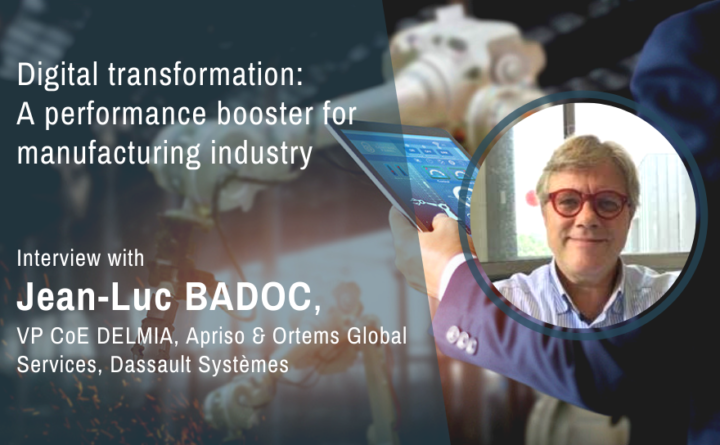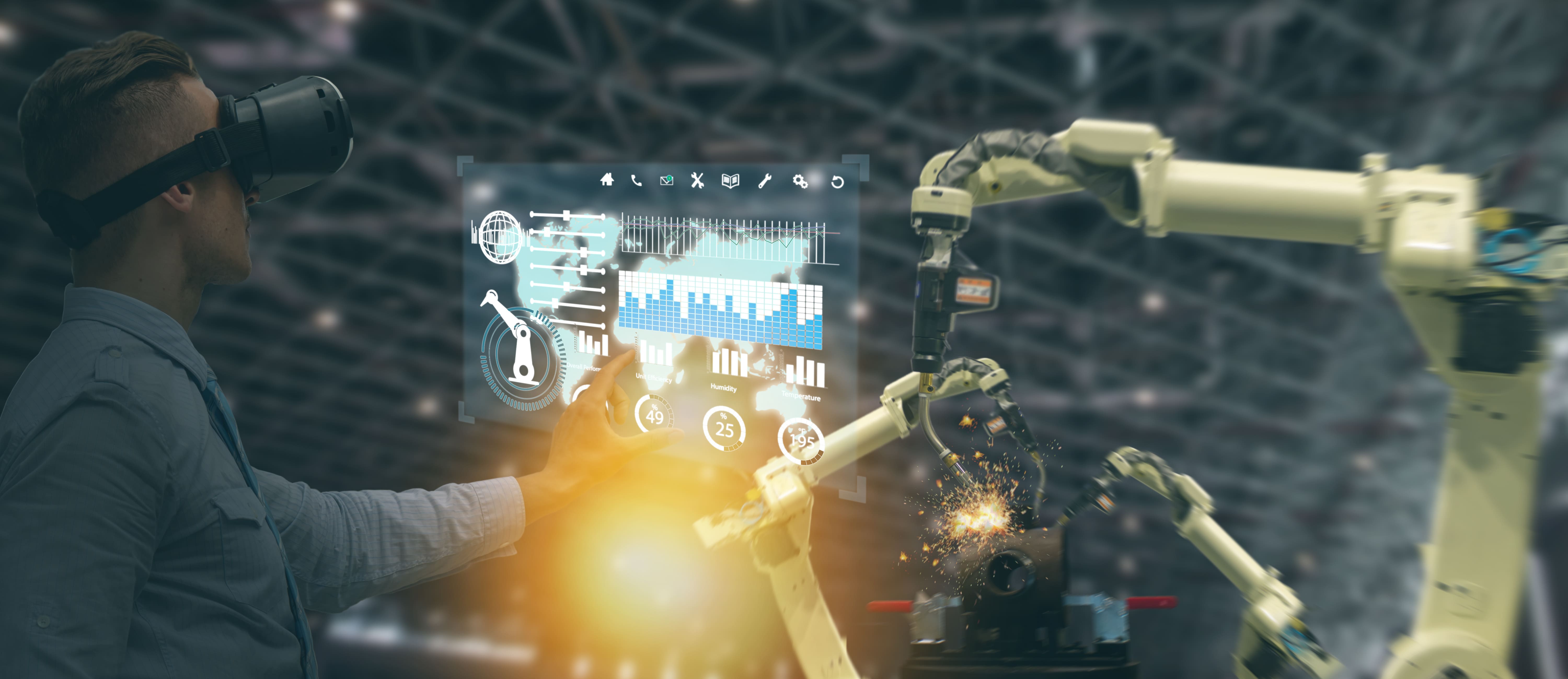Interview with Jean-Luc BADOC, VP CoE DELMIA, Apriso & Ortems Global Services, Dassault Systèmes
“Digital technology allows industry to change course as needed, while continuing to innovate”
When it comes to optimizing and streamlining manufacturing processes, digital solutions offer competitive, differentiating advantages to companies in the production sector, within the context of a globalized economy. Actors in the industry – whether large groups, SMEs, or startups – must embrace transformation to adapt to the ongoing changes in their markets. To succeed in this, they should make digitization part of their organizational methods and production systems. Collaboration, costs, quality, speed, and agility have become firmly established as the pillars of performance and innovation.
CENIT-KEONYS brings you an exclusive testimonial from Jean-Luc Badoc, VP DELMIA Apriso & Ortems Global Services CoE at Dassault Systèmes, on the challenges and benefits of digital manufacturing, with insights into the approach to transformation precipitated by the COVID-19 pandemic.
KEONYS: Can you give us a brief rundown on how the digital environment is a performance factor in the production sector?
JLB : La technologie DIGITAL MANUFACTURING de DELMIA, portée par la plateforme 3DEXPERIENCE® de Dassault Systèmes, permet aux fabricants de modéliser les processus de fabrication dès la phase de conception des produits avant le passage en réel sur les lignes de production. Ceci permet de virtuellement définir, simuler et optimiser l’ensemble des étapes du cycle du processus de fabrication. La continuité numérique permet de réduire les temps de cycle de mise sur le marché de nouveaux produits, d’initier la production dès le début du cycle et de s’adapter de façon dynamique à la demande du client.
KEONYS: How does digital technology help companies transform and even repurpose their production facilities?
JLB: Digital technology allows industry to change course as needed, while continuing to innovate. Thanks to its collaboration tools and shared data model, digitization breaks down the traditional silos that exist between engineering, methods, and production.
There are five key challenges that manufacturers can overcome by going digital:
- Production on demand
The specific features and constraints inherent to every product and service are amongst the core challenges faced by the manufacturing industry. The production sector must contend with regulatory requirements relating to aspects such as quality, the environment and safety, which call for great responsiveness and agility on the part of manufacturers. Clients want to purchase products that meet their configuration requirements and satisfy three imperatives: the ability to place orders as late as possible, receive deliveries as quickly as possible, and be guaranteed optimal quality at competitive prices. This is what is known as the “Order of One” in our lingo, which would be impossible to achieve without using digital tools.
- Reduced innovation cycle times
The ability of industry to adapt to evolving markets is crucial. But change comes at a cost. Digital simulations are a great tool, allowing manufacturers to dispense with physical prototypes and considerably reduce development cycle times. This is an opportunity to establish a significant competitive advantage in conquering new market shares.
- Shortened timelines between engineering and manufacturing
Product designs do not always take the planned manufacturing methods into consideration. Collaboration between the design and production teams is a key factor for success. To achieve best practices, the 3DEXPERIENCE® platform simultaneously pools and manages all of the design data and the data needed for production. In this respect, the 3DEXPERIENCE® platform becomes the single point within an information system for managing product ranges, nomenclatures, manufacturing processes, and the 3D assembly instructions used by production and purchasing via the ERP system.
- Getting it right first time
All manufacturing companies must implement a constantly evolving strategy for optimizing cycle times and the associated costs. Digitization allows them to make the most of virtual modeling and simulation to avoid/shorten production line launch phases for new products.
- Collaboration
Responsiveness is a major issue in the manufacturing industry, which must be able to adapt to unpredictable demand and rapid product evolutions. A factory’s operational efficiency is dependent on continuous process improvement. For example, during the manufacturing phase, the team may need to rework a part or reach out to engineering if they find an error in the assembly instructions or encounter a quality problem. The high degree of interaction between design, methods, and production offered by the 3DEXPERIENCE® platform allows methods managers to dynamically change production instructions to reschedule new work orders in light of any quality issues encountered.
KEONYS: How have companies used digital technology to “shift gears” since the start of the coronavirus pandemic?
JLB: At Dassault Systèmes, we have implemented a raft of initiatives to help manufacturers model and redefine their production chains within the singular context of the health crisis. The most urgent aspect of this related to the manufacturing of face masks. So we developed a contingency planning initiative for the supply chain that satisfied three criteria: supplying the right number of masks to the right people in order of priority.
Also, bringing production lines back into service with a tight backlog can be a real headache for manufacturers. Some of them have had to contend with shortages of raw materials and supplier failures, and others with the absence of employees at their sites, all while having to adhere to new physical distancing rules on the factory floor.
In light of this, we have established a package that allows our clients to safely restart production in just a few weeks.
Lastly, at Dassault Systèmes, we used the tools that we sell to coordinate our employees’ safe return to our sites, in accordance with all the constraints inherent to the pandemic.
KEONYS: Can you give us an example of a French company that shifted direction in its manufacturing?
JLB: There was a major player in the tire industry that, with the help of Dassault Systèmes, was able to set up production lines very quickly to manufacture surgical masks. Our Virtual Build* digital tools, which are rolled out on the 3DEXPERIENCE® platform, were used to model the factory and simulate its production lines, so production could be stepped up to satisfy market demand as quickly as possible. The masks were originally intended for the company’s employees and partners and they are now a permanent product line. This example shows that production facilities can be repurposed in a very short time while still meeting the required standards.
KEONYS: Digital technology, a reshoring accelerator?
“Bring back home globalized production lines in short time”
JLB: Reorganizing global production flows is a key focus of the French government. The digitization of manufacturing is a great opportunity to reshore what is being produced abroad.
Bringing production into our factories from elsewhere means helping manufacturers to model these new production lines as quickly as possible, structuring the supply chain to ensure that components and raw materials are delivered at the right time, and equipping clients with a manufacturing operations management (MOM) solution to help them coordinate production. Lastly, it means giving them the ability to plan their schedules as quickly as possible to meet market demand in an optimal way.
A leading aeronautics equipment manufacturer recently completed the successful repatriation of its production to France. To do this, it created and simulated its factory virtually and digitized its production lines to produce better products more quickly. Over and above manufacturing processes, digital transformation also provides employees with new skills and career opportunities. I’ll give you an example: the chief data officer or digital strategy director who helps steer the company’s global strategy. And there will be many more like this.
KEONYS: How does digital transformation work for customers vis-à-vis subcontractors?
JLB: One major automotive customer modeled and optimized its supply chain and logistics flows when designing a new range of vehicles. The goal was to ensure that the parts acquired from suppliers were in the right place at the right time in its assembly lines and production chains, based on the order book.
The 3DEXPERIENCE® platform can model the subcontracting chain and then optimize logistics flows and inventory management, in line with the order book and delivery imperatives.
KEONYS: What criteria should be used to choose the right technology partner?
JLB: One of the major challenges facing the manufacturing industry is the need to optimize the supply chain in real time and on a global scale, so as to meet product specifications as closely as possible and reduce storage costs. CENIT-KEONYS brings together all the necessary expertise to support manufacturers in their global digital transformation projects based on the 3DEXPERIENCE® platform. It is important to have a good command of cycle management, from design to digital manufacturing, and to understand the businesses and industrial processes involved in the logistics chain.
KEONYS: Are planning and scheduling key to industrial performance?
JLB: The reliability of planning is essential to anticipate resources and means of production. Planners play a key role at every level of the supply chain. They have to optimize the company’s production methods and be able to react in any situation – often urgently – to ensure the production lines never stop.
Transforming the purchasing process gives manufacturers the ability to plan in such a way that they can be responsive and satisfy their clients. This is why more and more manufacturers are opting for the DELMIA Ortems planning and scheduling solution, to reclaim control over their production schedules while simplifying their organization. Part of the 3DEXPERIENCE® platform, this solution improves collaboration between the factory floor, planning, purchasing, procurement, production, and sales, yielding significant and measurable productivity gains.
KEONYS: How can digital technologies help accelerate the environmental transition?
JLB: Technological change and digital innovations make it possible to anticipate and adapt our behaviors to new practices. They can be incorporated into the circular economy as a way of rethinking our production methods, thereby optimizing the use of our planet’s natural resources. A company that goes digital can decide to transform the way it designs its products, making them more durable and recycling components at the product’s end-of-life so they can be reused, all while remaining competitive.
Involving engineering and manufacturing in collaborative innovation fosters new opportunities for creativity on an economic, societal, and environmental level. It gives any company that puts sustainable development at the heart of its mission and growth strategy a real opportunity to differentiate itself.
*Virtual Build allows customers to optimize and approve the final assembly process in an entirely virtual environment that reproduces the product, the processes, and the production systems.






